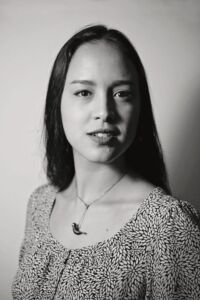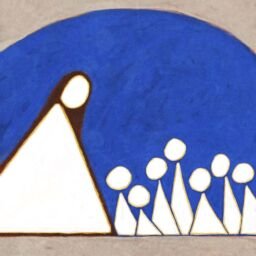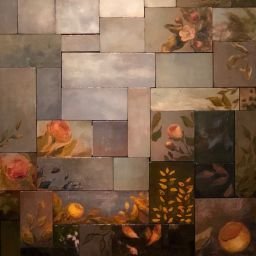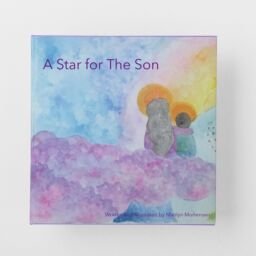Interview of Esther Hi’ilani Candari Conducted by McArthur Krishna
When I saw Esther’s work in the LDS Art Competition, I gasped. Her woman was so life-like and so powerfully warm and real… I knew I wanted to see what she would do for Heavenly Mother. Plus, in my own family, we have two in-laws of Hawaiian ancestry. I knew they (and all of us!) needed to see a Heavenly Mother in Her Polynesian glory. Esther told me about the crown— Hawaiians use to catch-and-release a rare bird to pluck one feather from them. The collective worth of all those feathers makes the tiara akin to a diamond crown. To me, she looks like a woman of deep and abiding warmth… just the way I had seen the first painting in the museum. Below is an excerpt from my interview with her.
-McArthur Krishna

Tell us a little about yourself.
Hahah. Where to start. I have always felt like a bit of social enigma due to my unique family and upbringing. It was a trial in high school but I have come to see it as a bit of a super power as an adult because it allows me to relate to and work with a wide range of people. To give you some context, I was born and raised in Hawaii by a Filipino-Chinese immigrant father and a white-but-acts-a-lot-like-a-Polynesian mother. That background in addition to the extensive traveling my family did while I was growing up allowed me to experience, and be immersed, in many different cultures which has greatly influenced my art as an adult.
I liked your art because of the richness of your woman’s faces… but how did you come to this style? How did you start painting?
I have always been fascinated with the rich variety of the human appearance and the complex emotions that can be communicated by the slightest of expressions. I also started out my career path with a serious interest in biology, so when I had an early life crisis and turned towards art I found myself quickly drawn to the technical precision and scientific approach it takes to accurately capture the human form. I was also blessed to study under two highly skilled figurative artists (one painter, one sculptor) during my undergraduate time; a circumstance that is actually quite rare in today’s higher education art scene.
As for how I even started painting in the first place. That took a bit of divine intervention. After the afore mentioned early life crisis I started off my undergraduate studies as a sculpture major. I always loved working with my hands and had talent for designing in 3D. Then, while I was on my mission, the art department at BYUH had their budget cut and one of the casualties was the sculpture program. When I returned I had the choice of transferring to another school or switching to painting or graphic design. After much prayer and agony I decided to switch to painting, despite the fact my painting experience was limited to elementary school water colors and the occasional decorative acrylic designs on furniture/nick-nacks. It was an extremely steep learning curve but it has been one of my greatest blessings in disguise.

What inspired you to create artwork about Heavenly Mother?
I grew up in a household where Heavenly Mother was considered common knowledge, even if she was rarely discussed, so I have always been comfortable with the concept of her. But I did not start to feel a strong personal desire to seek her until the last few years as I have begun to face serious questions of woman hood. Questions such as; what the purpose of my single-hood was and, when I finally met my husband, what the ramifications of marriage and potential future motherhood were for me. As I began to blossom and mature into adult womanhood I began to feel more and more left adrift by the male centric focus of church teachings. I won’t say doctrine because I believe the doctrine is equitable but the way we have interpreted it for so long has silenced or muted the sacred feminine in it. Over the years, I have created pieces that address some of these womanhood related questions that I have faced and Heavenly Mother has existed, sometimes consciously and sometimes subconsciously, on the fringes of my work but I never had the courage or appropriate opportunity to paint her directly until you invited me too. When you did though, it felt right. It felt like the culmination of many of my artistic and spiritual searchings.
What is the significance and story behind this piece for the The Girls Guide to Heavenly Mother book?
I don’t profess to be someone who receives clear spiritual guidance on many things but my best pieces always come to me as images and ideas untainted by the usual jumble of thoughts that exists in my mind. I have no doubt these thoughts are guided by divine power. This piece was one of those pieces. As soon as I started discussing the topic and your vision for the type of piece you needed the face of my model appeared clearly to me along with an array of tropical plants that represent nourishment, family, and strength. For a few days afterwards I poked, prodded, and counter argued that image in my mind but it kept coming through like a clarion call so knew I needed to pursue it. One of the biggest challenges though was the fact that the model I had in mind was thousands of miles away in Hawaii and I had neither the time nor the money to travel there. So I decided to see if my mother would be able to take some reference photos for me. I called her and began explaining the general concept of my project and before I could get the words out of my mouth she interjected, “You should use Aunty Emma as the model.” That was the exact woman I was calling to ask her to take photos of. Her words further confirmed the divine purpose of this project and the knowledge of that divinity helped me to power through a 100+hr painting in two months when it seemed my schedule was already full to the brim.

The name of this piece is also significant and was a well thought out and researched part of my process. In Polynesian languages names are gender neutral a vast majority of the time. The title of the painting “Makua” in an endearing and respectful term for ‘parent’ in the Hawai’ian language. It is typically used for Heavenly Father among devout Christian Hawaiians but, due to its gender neutrality, it can be used for Heavenly Mother as well.
How has the process of creating artwork about Heavenly Mother brought you closer to Her? What has it taught you about Her? About yourself?
There is so much I could say here but some of it I don’t have words for and other parts feel too sacred to share. But to put it simply, it has empowered me. This painting, and the journey it is a piece of, have resurrected the wings that I didn’t even realize had been clipped by narrow minded individuals.
What advice would you give to those who want to connect with their Heavenly Mother on a deeper level?
Seek her. Once you start looking she is not hard to find. Some of the most interesting theological writings I have read during my research for my masters thesis has been about how our cultural perceptions of life deeply color our interpretation of scripture and limit our ability to see even the most simple concepts in new or liberating ways. Once you stop reading ONLY Heavenly Father into every divine reference and occurrence in your life you will realize She has been there all along.
If you were to sit down and have a face-to-face conversation with Heavenly Mother, what would you talk about or ask?
What is the purpose of childbirth often being a near death experience?






